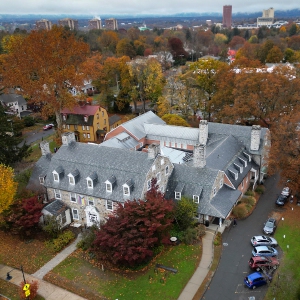Earth Matters: Observing climate change without leaving home
| Published: 06-01-2023 6:26 PM |
In Henry Thoreau’s essay “Walking,” he tells us that to preserve his health and spirits he “spend(s) four hours a day… sauntering through the woods and over the hills and fields.” He writes in his journal, “I wonder that I even get five miles on my way, the walk is so crowded with events and phenomena.”
For most of us, spending four hours a day naturalizing is not an option, but I take his point — we can learn about our environment by paying attention to events around us. Through observation we create a baseline for what we’ve come to expect from our environment, and what might be changing.
Locally, the past 12 months have provided some telling observations. Last summer, it was obvious that we needed rain. Meadows turned brown, streams dried up, farmers irrigated fields, and a drought was declared. In one area of our woods, smaller white pines turned brown. Were they falling victim to the drought, but why in this section of woods?
On Sept. 19, the question was answered. Scattered thunderstorms were forecast. In the west the sky darkened, light rain fell. Without warning a violent wind carrying a wall of water hit and shook the house. We raced to shut the windows; wind and rain blew curtains out straight, a bedroom filled with a turbulent mix of air and water. It was over as quickly as it began. We were hit by a microburst releasing straight-line winds that may have exceeded 60 mph.
Outdoors, torn leaf confetti plastered the house, the deck umbrella was broken, a window screen was jettisoned onto the roof, shingles were uplifted. We were shocked to find more than a dozen large trees, 8 to 24 inches in diameter — oaks, maples, pines, hickories – blown down and lying west to east, the direction of the microburst winds. The larger trees were 50 to 60 years old.
One tipped-up oak had an exceptionally wide root system, 14 feet in diameter, and a shallow 20 inches deep. At the bottom was a flat layer of sedimentary red rock. These south-facing woods were sitting on a 2 million-year-old ledge of Mesozoic Era stone. The blowdowns, with a full crown of leaves and shallow roots, were easy targets for the violent winds.
The south-facing ledge, absorbing the sun’s radiant heat, has always been drier than the surrounding woods. With normal rainfall, the pines survived. With the added stress of severe drought, the vulnerable pines expired. In a few short moments the microburst and drought joined to dramatically change the tree species composition and structure of a woods that had developed over six decades.
Is this the type of extreme event that climatologists predict will become more common? The National Oceanic and Atmospheric Association reported that 2022 was the sixth-warmest year on record; last summer was the second-warmest and tenth-driest on record. The drought was declared over in mid-February 2023 due to five months of above-normal rainfall. There were 6.28 inches of rain in January 2023, 3 inches above average.
Article continues after...
Yesterday's Most Read Articles
 ‘Home away from home’: North Amherst Library officially dedicated, as anonymous donor of $1.7M revealed
‘Home away from home’: North Amherst Library officially dedicated, as anonymous donor of $1.7M revealed
 Around Amherst: Bockelman joins in launch of governor’s housing push
Around Amherst: Bockelman joins in launch of governor’s housing push
 June dates set for big school vote in Belchertown
June dates set for big school vote in Belchertown
 Ken Rosenthal: Time to change direction on Jones Library
Ken Rosenthal: Time to change direction on Jones Library
 Political newcomer defeats Shores Ness for Deerfield Selectboard seat
Political newcomer defeats Shores Ness for Deerfield Selectboard seat
 Town manager’s plan shorts Amherst Regional Schools’ budget
Town manager’s plan shorts Amherst Regional Schools’ budget
University of Massachusetts’ Climate Research Center reported that Massachusetts’ January was the warmest on record. But something was missing: snow. The average snowfall by mid-February is 50 inches, while the actual was only 11 inches.
Signs of rising temperatures appeared in other unexpected places. In December, while cutting holiday hemlock tree greens, I was saddened to find the woolly adelgid’s white cottony egg sacs along the twigs’ undersides. This invasive aphid-like insect was introduced from Japan to Virginia in 1951. Juveniles feed on the hemlock’s sap, killing the tree in 3-5 years. Its northward spread had been curtailed for decades by freezing temperatures and winter kill.
Shorter, warmer winters have facilitated the adelgids’ spread as far north as Maine. Similar climatic factors have contributed to the spread of the Lyme disease-infected blacklegged tick.
Winterberry, our native holly, with its spikes of bright red berries, is a festive addition to the winter landscape. Predictably in December or January, a flock of robins or cedar waxwings will descend on our bushes, stripping them bare of berries. For the first time in memory, neither robins nor waxwings arrived. Throughout the winter and spring the wizened berries clung to their stems.
With warmer winter temperatures and snowless landscape, these short-distance migrants from northern populations had ample feeding grounds without drifting south.
Sugar maples also signaled warming temperatures. Local syrup producers have found the sugaring season starting 10 to 14 days earlier than a decade ago, when the typical season started in mid-February and ended in late March. Some producers are now starting production in January. Harvard Forest researchers project that by century’s end, Massachusetts syrup production will start a month earlier and produce half of its current output.
Yes, we’ve had warm spells and dry spells before, the weather can be fickle. But this is different.
Over decades, weather reports have been accumulating, revealing new patterns. These patterns show us what a warmer climate looks like — not in some faraway place or distant time, but in the here and now. As Thoreau suggests, you don’t have to go far to observe it right in our own community.
The ecosystems in which we live are responding, as are the various life forms within them: trees, plants, insects, birds, people. While the signs may be as subtle as an insect’s behavior, or as violent as a microburst, the monumental fact is we humans are dramatically changing the earth’s climate. In its March report, the U.N.’s Intergovernmental Panel on Climate Change calls for urgent action. There is little time to spare.
Tom Litwin (he/him) is a conservation biologist and former director of the Clark Science Center at Smith College. He is retired from the Jackson Laboratory in Bar Harbor, Maine and Farmington, Connecticut.
Earth Matters has been a project of the Hitchcock Center for the Environment for 14 years. After more than three years of the COVID-19 pandemic, the center’s doors and trails are once again open at 845 West St. in Amherst. To learn more, visit hitchcockcenter.org.

 Sharing a few notes: High schoolers coaching younger string players one on one
Sharing a few notes: High schoolers coaching younger string players one on one Reyes takes helm of UMass flagship amid pro-Palestinian protests
Reyes takes helm of UMass flagship amid pro-Palestinian protests Sole over-budget bid could doom Jones Library expansion project
Sole over-budget bid could doom Jones Library expansion project Amherst poised to hire police department veteran as new chief
Amherst poised to hire police department veteran as new chief 